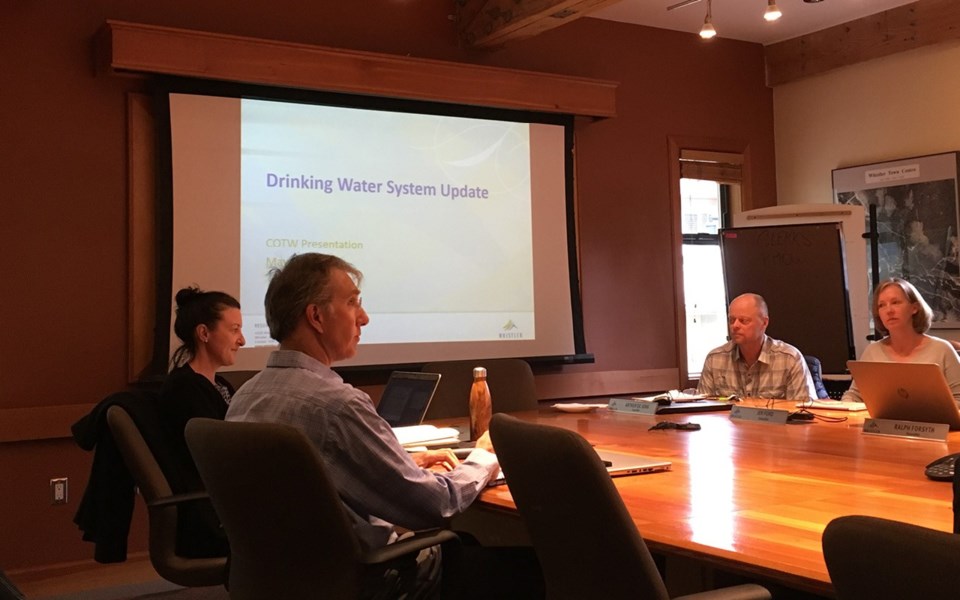Whistler's water reserve funds are "adequate" (assuming a "like-for-like" replacement) but to build more water supply will be prohibitively expensive—to the tune of "millions and millions" of dollars.
"That is why we are continuing to work with the community and businesses to find out ways to best manage our existing supply infrastructure," said utilities group manager Gillian Woodward, in presenting an update on Whistler's drinking water system at the May 14 Committee of the Whole meeting.
Some of the work in progress includes a water leakage reduction program (a request for proposals is underway), development of a "cross connection control" bylaw (to prevent water used for industrial purposes contaminating the drinking water system; scheduled to come to council next month) and ongoing public education around Whistler's new water use bylaw (introduced last year—see Pique, April 19, 2018).
"What is ranked as the next most cost-effective method for (increasing) water conservation—so to keep us on the path of using what we've got and not have to expand our supply—is water metering," Woodward said, adding that the municipality is looking at industrial, commercial and institutional water usage data this year.
"We need to do a rates analysis, so that ... if we move to the point of delivering utility bills like that, people know what they can expect," she said.
A 2014 water supply plan found that there are several large bodies of water that could serve to bolster Whistler's supply, but building the necessary infrastructure to treat and deliver the water quickly adds up, Woodward said—and that doesn't factor in the cost of operation, maintenance or inflation, or the significant approval process that comes with developing a new water source.
"If we as a community needed $20 million in 10 years, say, to bridge the supply gap, then we need an additional $2 million a year, not factoring in inflation or fancy things like that," Woodward said. "So that would require an increase of 28 per cent to the current water parcel tax and user fees."
That increase would amount to about an extra $100 per user annually, she added.
The prospect of increasing the supply has been looked at before, and "it's not a place we want to go," said general manager of infrastructure James Hallisey.
"Can we conserve enough to keep the lid on it, and not have to have these huge expenditures?" he said. "We are getting close to our bed cap so it seems realistic that we could live with what we've got and never have to go down this road. That's our goal."
The local water supply is complex, coming from both surface and groundwater sources—the main source being 21 Mile Creek between Sproatt and Rainbow Mountains, which provided between 38 and 53 per cent of Whistler's water supply over the last five years (council endorsed a Source Water Protection Plan for 21 Mile Creek last year—see Pique, July 12, 2018).
The remainder comes from 13 active supply wells, which are covered in a Ground Water Protection Plan (currently under review for an update this year).
Also of concern is the need for corrosion control at eight treatment stations to address the lower pH levels typically found in Whistler's groundwater sources.
A low pH is a major factor (though just one of many) in the corrosivity of water.
Corrosive water can leach metals like lead and copper from plumbing fixtures, as was the case in the Village of Pemberton in 2016.
Vancouver Coastal Health's 2019 Evaluation Report states that "options for pH adjustment should be investigated and a long-term plan finalized as a means of improving the chemical stability of the treated drinking water."
A draft report received by the Resort Municipality of Whistler last month shows the cost for each station will be between $500,000 and $1 million, not counting the cost of land.
"We're in a unique situation that when 21 Mile Creek is running, this is not an issue, so the discussion is, will we spend this amount of money, which is not in our present funding, to fix a situation that only occurs part of the time?" Woodward said, adding that pH can't be considered in isolation when trying to address the issue.
The RMOW will take its draft report back to VCH before it considers its next steps. In the meantime, residents are reminded to flush their taps each morning.
A total of 448 bacteriological samples were taken throughout the system last year, testing six parameters (coliforms and E. Coli, turbidity, residual chlorine, temperature and pH) only one of which had to be retested.
"It was felt that that must have been an issue with taking the sample rather than something wrong with the system," Woodward said.
"Whistler consistently has a low hazard rating, meaning there is not considered any issues with the system."




